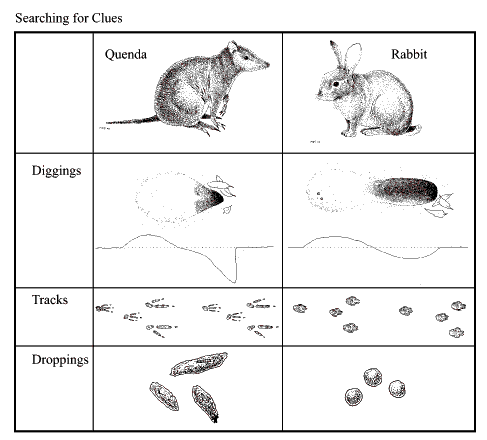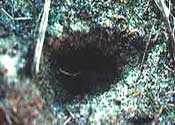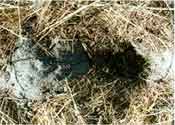| Mammals
Native
Mammals
Introduced Mammals
Native Mammals
Quenda
The Aboriginal name ‘Quenda’ is used
for the western form of the Southern Brown Bandicoot.
| Description:
Quendas are brown, furry marsupials with long noses, whiskers
and short ears. They have thin, round tails which are about
half as long as their bodies. Adult Quendas weigh up to two
kilograms and measure up to 50 centimetres in length, including
their tail. Like all bandicoots, the second and third toes
on Quendas’ hind feet are syndactylus, which means that
they are fused together. Quendas use their double toenail
like a comb when they groom themselves. |
 |
 |
The hind foot of a Quenda.
The double toenail is visible in the lower half of the picture. |
Distribution:
Quendas are found only in south-western Australia. They like dense
bushland and still occur in in the hills and swampy areas around
the cities of Perth, Mandurah and Bunbury. They are most often
found in suburbs near to patches of bush and those with bushy,
native gardens. In areas where cats and foxes are controlled,
Quendas may become frequent visitors to suburban gardens.
Diet: The diet of Quendas includes snails,
worms, beetles, small lizards, roots and leaves.
| Breeding:
Like all marsupials, female Quendas carry their young in
a pouch. Unlike kangaroos, Quendas’ pouches open backwards.
This feature may help to stop their pouches filling with
sand when they dig.
Quenda’s pouch: the tiny foot of a Quenda joey is
visible in the opening. |
 |
Reason for Decline:
The number of Quendas has decreased dramatically.
The main causes are land clearing for agriculture and housing
and predation by feral animals, especially cats and foxes. In
areas of bush where foxes and cats have been removed, Quendas
have become more common.
Looking for Evidence of
Quendas

Diggings: Quendas dig narrow, triangular
holes while looking for food. Their diggings are easy to find
in areas where Quendas are common. Sometimes it is possible to
see the imprint of the animal’s nose in the point of the
triangle.
| Quenda
digging

|
Rabbit
digging

|
Rabbit diggings tend to be rounded as their
noses are blunt and so they need to dig wider holes to fit their
noses.
Tracks: Hunting for tracks is another
way to tell if there are Quendas in an area. A patch of smooth,
damp sand is the best place to look. A clear set of Quenda tracks
is quite different to the tracks of a rabbit.
Spotlighting: The most exciting way
to look for Quendas is to sit quietly with a torch at night and
watch. Even if you don’t see a Quenda, you might be surprised
by the range of other creatures that you see.
Quendas have been reintroduced
to the Creery Wetlands Nature Reserve click
here to find out more
Back
Bats
Several species of native bats
live in the reserve. They hide under bark and in hollow trees
during the day, and emerge at night to forage for insects.
The Lesser Long-eared Bat (Nyctophilus
geoffroyi) illustrated on the right is a common bat of forests
and coastal plain areas of the South West of Western Australia.
Could Native Animals live
in Your Suburb?
Most native animals prefer to live in bushy
areas that are similar to their natural habitat. If you live in
a suburb where patches of bush have been left or people have planted
bush gardens then there are probably many native birds, frogs,
lizards and insects in your garden. If you live in Western Australia,
you might even have a Quenda.
What could you do to help native animals survive
in your area?

Back
Introduced Mammals

Fox
The European Fox is a serious predator of native
wildlife. Foxes have been removed from the reserve and a predator
exclusion fence has been built to keep them from recolonising
the area.
Back
Rabbit
Rabbits graze the native vegetation and must
be controlled for rehabilitation to be successful.
Back
Rats and Mice
Black Rats (Rattus rattus) and Ship
Rats (R. norvegicus) occur on the reserve. House mice
(Mus musculus) are also common. These introduced rodents
are common in most parts of Australia.
Back |



